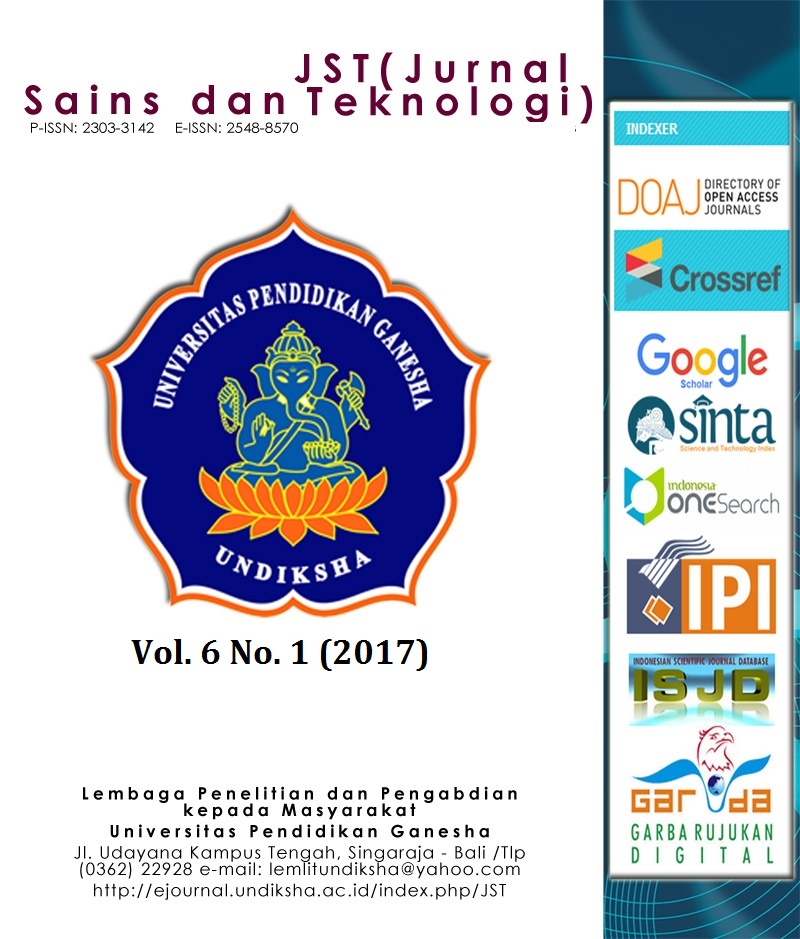SISTEM PENCARIAN PROGRAM STUDI PADA PERGURUAN TINGGI DI BALI BERBASIS SEMANTIK
DOI:
https://doi.org/10.23887/jstundiksha.v6i1.9111Kata Kunci:
web semantik, ontologi, program studi, recall, precisionAbstrak
Pendidikan di Indonesia berlangsung secara berjenjang, dimulai dari pendidikan dasar sampai dengan pendidikan tinggi. Pendidikan tinggi diselenggarakan oleh berbagai satuan penyelenggara, seperti Akademi, Sekolah Tinggi, Institut, dan Universitas. Calon mahasiswa sebelum menentukan pilihan program studi dari sebuah perguruan tinggi harus melakukan pencarian informasi berkaitan dengan program studi. Pencarian informasi dapat diselesaikan dengan membangun sebuah sistem pencarian berbasis semantik. Ontologi menjadi dasar dari penerapan web semantik karena dapat merepresentasikan konten menjadi basis pengetahuan yang dapat dipahami oleh mesin, sehingga mesin dan pengguna memiliki pemahaman makna kata kunci yang sama. Sistem ini membantu calon mahasiswa untuk mendapatkan deskripsi informasi program studi yang diinginkan. Pada tahapan pengujian sistem, diperoleh hasil nilai recall sebesar 0.95 dan nilai precision sebesar 0.93, yang menunjukan bahwa sistem memiliki tingkat relevansi dan ketepatan pengembalian informasi yang tinggi. Selanjutnya diharapkan bahwa sistem ini mampu mengakomodasi detail informasi program studi dari seluruh perguruan tinggi di Indonesia.Referensi
Reasoners and Comparison. International Journal of Computer Applications, 57(17), 33–39.
Atmanti, D. H. (2005). Investasi sumber daya manusia melalui pendidikan. Jurnal Dinamika Pembangunan (JDP), 2(1), 30–39. Retrieved from http://eprints.undip.ac.id/16864/1/Investasi_Sumber_Daya_Manusia_Melalui_Pendidikan....by_Hastarini_Dwi_Atmanti_(OK).pdf
Berners-lee, T., Hendler, J., & Lassila, O. (2001). The Semantic Web. Scientific American, 21. doi:10.1007/978-3-642-29923-0
Chandrasekaran, B., Josephson, J. R., & Benjamins, V. R. (1999). What are ontologies, and why do we need them? IEEE Intelligent Systems and Their Applications, 14(1), 20–26. doi:10.1109/5254.747902
Changping, H., & Yang, Z. (2007). An ontology-based framework for knowledge service in digital library. 2007 International Conference on Wireless Communications, Networking and Mobile Computing, WiCOM 2007, 5340–5343. doi:10.1109/WICOM.2007.1309
Davies, J., Fensel, D., & Harmelen, F. van. (2003). Towards The Semantic Web (Ontology-driven Knowledge Management). John Wiley & Sons Ltd.
Davies, J., Fensel, D., & van Harmelen, F. (Eds.). (2003). Towards The Semantic Web. England: John Wiley & Sons Ltd.
Gerber, A., Van Der Merwe, A., & Barnard, A. (2008). A functional semantic web architecture. Lecture Notes in Computer Science (including Subseries Lecture Notes in Artificial Intelligence and Lecture Notes in Bioinformatics), 5021 LNCS, 273–287. doi:10.1007/978-3-540-68234-9_22
Gómez-Pérez, A., Fernández-López, M., & Corcho, O. (2003). Ontological Engineering with examples from the areas of Knowledge Management, e-Commerce and the Semantic Web. Springer.
McGuinness, D. L., & Harmelen, F. Van. (2003). OWL Web Ontology Language Overview. http://www.w3.org/TR/owl-Features/, 2004(February), 1–12.
Mehta, A., Makkar, P., Palande, S., & Wankhede, P. S. B. (2015). Semantic Web Search Engine (SWSE), 4(04), 687–691. Retrieved from http://www.swse.org/
Novianti, K. D. P. (2016). IMPLEMENTASI METHONTOLOGY UNTUK PEMBANGUNAN MODEL. Jurnal TEKNOIF, 4(1), 40–47. Retrieved from https://ejournal.itp.ac.id/index.php/tinformatika/article/view/588/424
Noy, N. F., & McGuinness, D. L. (2001). Ontology Development 101: AGuide to Creating Your First Ontology. Stanford University.
Noy, N., & McGuinness, D. (2001). Ontology development 101: A guide to creating your first ontology. Development, 32, 1–25. doi:10.1016/j.artmed.2004.01.014
Unduhan
Diterbitkan
Cara Mengutip
Terbitan
Bagian
Lisensi
Authors who publish with the Jurnal Sains dan Teknologi (JST) agree to the following terms:
- Authors retain copyright and grant the journal the right of first publication with the work simultaneously licensed under a Creative Commons Attribution License (CC BY-SA 4.0) that allows others to share the work with an acknowledgment of the work's authorship and initial publication in this journal.
- Authors are able to enter into separate, additional contractual arrangements for the non-exclusive distribution of the journal's published version of the work (e.g., post it to an institutional repository or publish it in a book), with an acknowledgment of its initial publication in this journal.
- Authors are permitted and encouraged to post their work online (e.g., in institutional repositories or on their website) prior to and during the submission process, as it can lead to productive exchanges, as well as earlier and greater citation of published work. (See The Effect of Open Access)
















